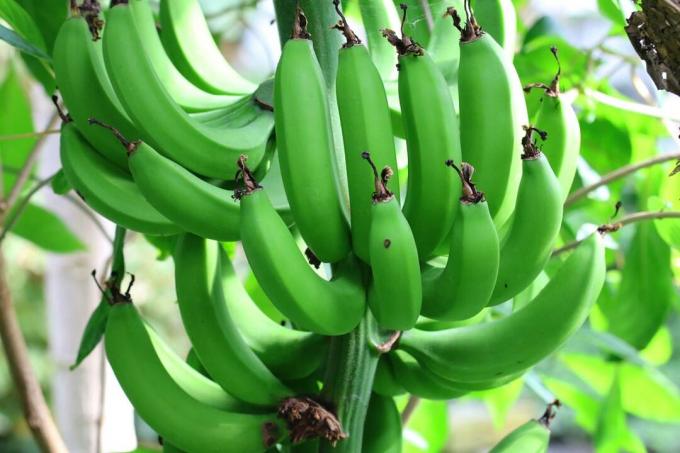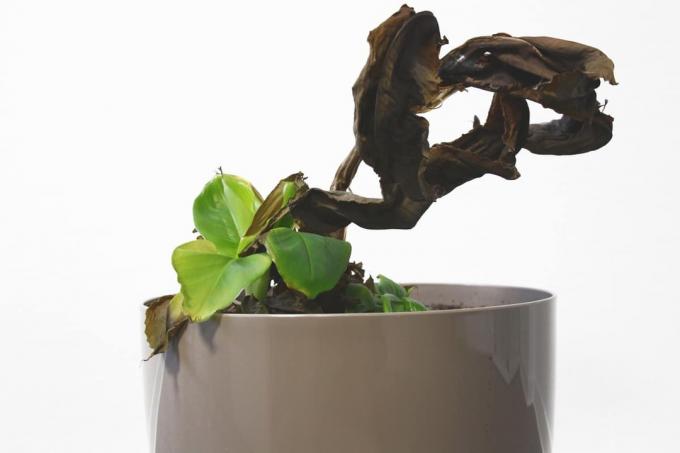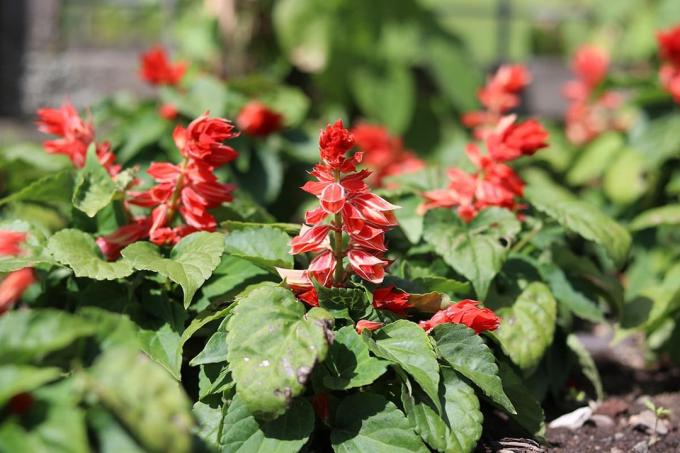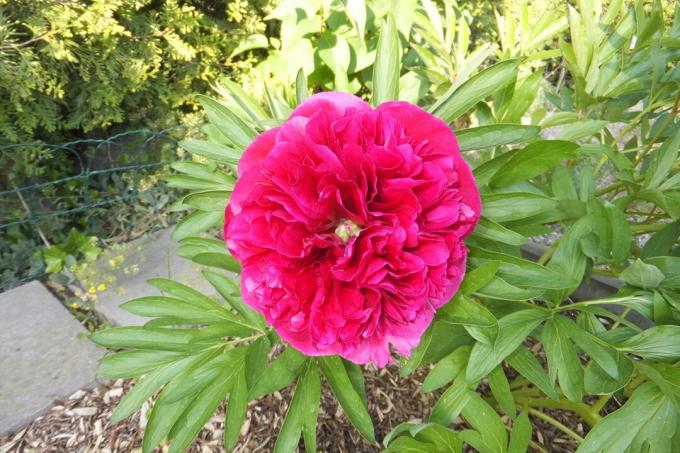

Table of contents
- Characteristics
- Overwinter frost-free
- High humidity
- Ideal fertilizing
- Is a cut necessary?
- Dust regularly
- Proper casting
- avoid pests
- Outdoor or indoor location?
- Repotting is important
- Propagating by offshoots
Tropical, imposing and decorative, this is the banana tree when cultivated as a houseplant or in a conservatory. In summer, the Musa can even move outside in the bucket to the terrace, the balcony or the garden.
Characteristics
- Origin tropics in Asia and the Pacific region
- bot. Surname: Musa
- Banana family (Musaceae)
- around a hundred species known
- cultivated as a houseplant in local latitudes
- May to September also outside in the bucket
- Fruit can be eaten
- large and colorful flowers only on old perennials
- Ornamental foliage perennial with very large green or red leaves
- growing up to two meters high
Overwinter frost-free
The hibernation of the banana tree should definitely be frost-free. Even if there are now bred varieties that can also be used in the garden in the local latitudes during the winter allowed to spend, the original banana tree is not hardy and therefore needs the appropriate Care:
- Location bright and cool
- an unheated conservatory is ideal
- alternatively a bright staircase
- Temperatures at least 10° Celsius
- spend in winter quarters in autumn
- Heating air in living rooms damages the plant
- Monthly fertilizer application over the winter
- water less than in summer
- However, never allow the soil and root ball to dry out
Wintering in a tub on the balcony or terrace is only possible in mild regions. In such a case, the bucket and the entire plant must be protected with a plant fleece. A location in a sheltered corner is ideal.
A notice:
A dark hibernation is not ideal, but if no other room is available, this is still possible. In such a case, however, you must reckon with a loss of hands. The plant stays smaller because it has to grow new leaves again next spring.
High humidity
The banana tree does not require much care, but it is important that, especially indoors in the direct Humidity prevails in the Musa's environment, so that the decorative leaves do not have brown edges or tips receive:
- Spray daily with room-warm, decalcified water
- especially important in winter
- dry heating air leads to yellow leaf edges
- place bowls of water around the plant
- Alternatively, use an electric humidifier
- a table fountain next to the plant has a decorative effect
- Cultivating a banana tree in hydroponics
- water from the pot also evaporates upwards
A notice:
The water for spraying should be lime-free, above all, because otherwise it would be unsightly, white Leaves lime stains on the large, decorative leaves, which are also not so easy to wipe off permit.
Ideal fertilizing

Bananas need to be fertilized regularly so that they can grow quickly and decoratively. When fertilizing, it is important to ensure that the root ball does not dry out after the application. Otherwise, root damage can occur here, which can damage the plant as a whole:
- fertilize from March to October
- once a week
- the selected fertilizer should be chosen for green plants
- contains all the important nutrients for the banana tree
- also trace elements and vital substances for healthy growth
- Pay attention to the manufacturer's information regarding the quantity
- Give liquid fertilizer with the irrigation water weekly
- alternatively put fertilizer sticks in the ground
- this is a long-term fertilization for three months
A notice:
If your banana tree shows light yellow leaves, then the plant is most likely suffering from a lack of nutrients and will have to be fertilized accordingly in the subsequent period. Repotting in fresh, nutrient-rich substrate can also be helpful in such a case,
Is a cut necessary?
Even if the banana tree is well tolerated by pruning, it usually does not need pruning:
- leaves that are too large can be cut off
- also remove old leaves
- Cut is often recommended for reasons of space
- Always cut leaves directly at the base
- Use cleaned and disinfected secateurs
- pure alcohol for this is available in the pharmacy
Dust regularly
The large leaves of the banana tree are also to be cared for. Because dust can quickly settle on it, which should be removed regularly:
- not just a visual issue
- too much dust prevents the absorption of moisture from the air
- therefore dust once a week with a soft cloth
- run carefully over the leaves
- can tear easily
Proper casting
A banana tree is mostly water. Therefore, even moisture in the soil is very important for the plant. Intermittent drying out or waterlogging is therefore not well tolerated:
- water every day in summer
- at least every two days
- in strong sunlight
- at high temperatures
- immerse small plants once a week
- fill a large bucket with water
- Submerge plant with pot
- as long as air bubbles rise
- Root ball gets totally soaked
- Half an hour later drain the drip tray
Tip:
The watering of the banana tree depends above all on the ambient temperature. The cooler it is at the chosen location, the less the plant needs to be watered.
avoid pests
Unfortunately, there are various pests that like to attack banana plants. It is therefore all the more important to take good care of them so that an infestation can be avoided:
spider mites
- silvery dots on leaf surface
- Webs on the underside of the leaf
- Infestation mostly at high temperatures and low humidity
- Wash leaves and care and alternatively change location
scale insects
- white bumps in leaf axils
- wipe with cloth
- Oils help against the infestation

Outdoor or indoor location?
For proper care, the banana tree first needs the right location. This can be chosen all year round in an indoor room. However, it is also possible for the plant to spend the summer months in a bucket on a terrace, balcony or completely outdoors in the garden:
- bright, warm location in the house
- ideal near a window or balcony/terrace door
- Conservatory also suitable
- Avoid drafts
- high humidity should be given
- choose a sunny spot outdoors
- older plants in particular need sun
- sheltered from strong winds against a brick wall or wall
- in partial shade growth is slower
- Winter quarters also bright
Tip:
If you put your banana tree outside in the spring, you should do this step by step get used to the sun, otherwise unsightly burns can quickly develop on the decorative leaves come.
Repotting is important
So that the bananas always have enough space in the bucket, it is important to repot at least every two years and to choose a larger container for this. Repotting should always be done in spring, when the days are getting longer again and the light supply stimulates growth:
- new vessel about 15 to 20 centimeters larger
- Never plant bananas too deep
- choose potting soil as substrate
- a peat-sand mixture with a lot of structure is also recommended
- must not bind the moisture too strongly
- Soil must be permeable
- create drainage on the bottom of the pot to prevent waterlogging
- gravel or shards of pottery, or -balls
- plant fleece over it
- then fill in the soil
When two-thirds of the prepared soil has been filled in, the root ball is placed on top and the rest of the soil is filled in. After that, the soil must be well watered. Before inserting, the root ball can also be immersed in a bucket of water until no more air bubbles rise.

Propagating by offshoots
The banana trees have rhizomes that can be easily divided for propagation. New leaves will quickly sprout from the small piece of root that has been cut off. The ideal time for propagation is during repotting, as this is when the root ball is exposed:
- use a clean and disinfected knife
- cut off small root parts
- place in small pots with potting soil
- cover with transparent foil
- air regularly
- keep soil moistured
- new leaf shows up, repot
A notice:
You have to be careful with the choice of location for the young plants that have arisen from offshoots. Direct sunlight is not recommended here in the first year, as otherwise the young leaves could burn quickly.
 garden editorial
garden editorial I write about everything that interests me in my garden.
Learn more about perennials

20 hardy plants that bloom all year round
With plants that flower all year round, you can quickly create an attractive garden that does not require much maintenance, as long as the plants are also hardy. In this post, we will introduce you to 20 plants that are suitable for this.

17 flowering hardy plants May to October
Many plants only show their full splendor for a short time. But there are also types and varieties with a particularly long flowering period from May to October, sometimes even longer. We present 17 flowering hardy plants.

Hardy perennials: 22 perennial bloomers
Hardy perennials as permanent bloomers in the flower bed enchant the garden from early summer to autumn with a colorful bloom. They are easy to care for and magically attract butterflies, bees and the like.

Properly care for globe thistle | 10 tips for care
The globe thistle is an eye-catcher in the garden. Their spherical flowers provide a food source for insects. The globe thistle is not difficult to care for and it is suitable for dry locations. With a few tips on care, the plants will develop even better.

Fire sage, Salvia splendens: care from A to Z
Fire sage is known in botanical jargon as Salvia splendens and is a particularly decorative eye-catcher. But what kind of care does the plant need? Our guide to the salvia shows the important points from A to Z.

Peonies, Paeonia: 11 tips for care
Peonies enchant with their extremely decorative flowers, which draw everyone's attention. In order for the flowers to be particularly lush and to last for a long time, care must be taken accordingly. Our tips show how the Paeonia thrives best.



